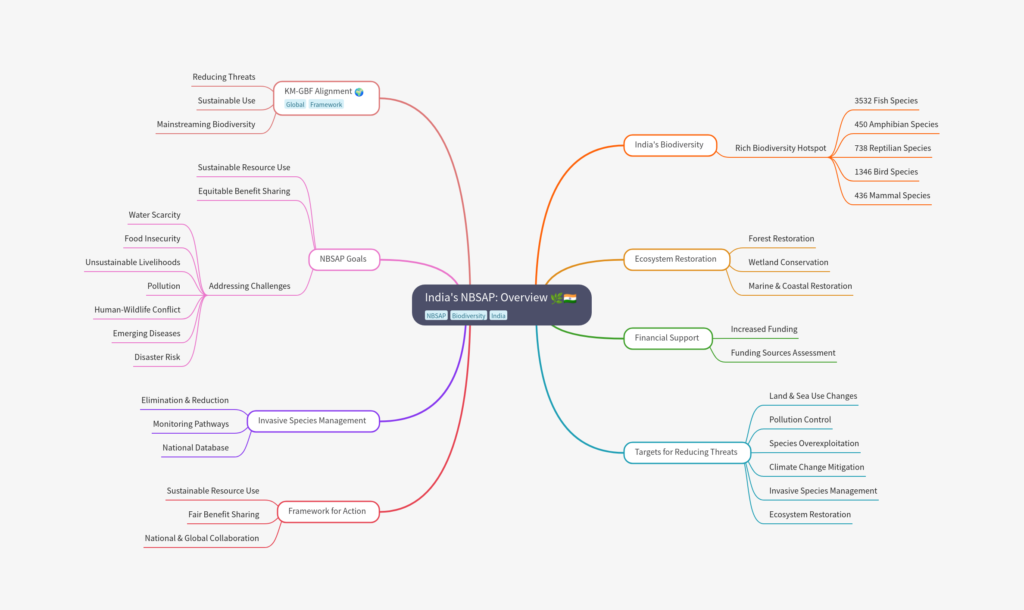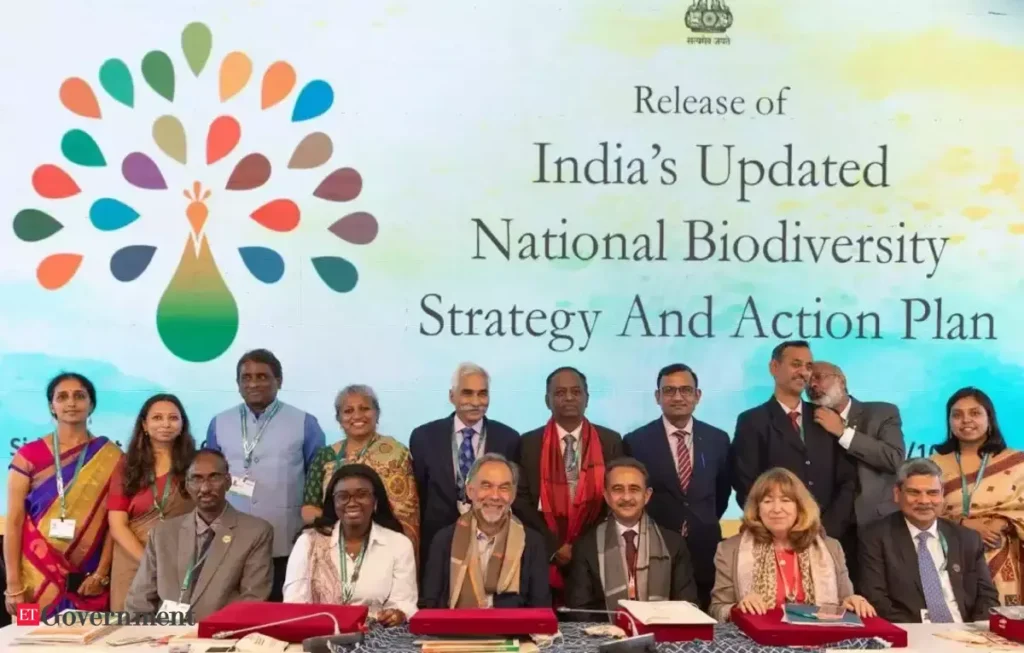Table of Contents

Introduction
India presented its updated National Biodiversity Strategy and Action Plan (NBSAP) at the UN Conference on Biodiversity in Cali, Colombia, aligning with the Kunming-Montreal Global Biodiversity Framework (KM-GBF). This plan reflects India’s commitment to preserving its unique and diverse natural heritage, addressing the challenges posed by biodiversity loss, and contributing to the global goal of achieving a “nature-positive” world by 2030.
This article delves into the key elements of India’s NBSAP, highlights the objectives of the KM-GBF, and explores how India’s targets and strategies are tailored to address local and global biodiversity challenges.
Understanding the Kunming-Montreal Global Biodiversity Framework (KM-GBF)
The KM-GBF, a pivotal framework, was established to halt and reverse biodiversity loss globally by 2030. With the backing of 196 countries, it offers a roadmap for creating a sustainable and biodiverse future. Structured around three main themes, the KM-GBF serves as the blueprint for nations like India to align their biodiversity goals and actions effectively:
- Reducing Threats to Biodiversity: Addressing factors such as habitat destruction, pollution, over-exploitation, and climate change to reduce the drivers of biodiversity loss.
- Meeting People’s Needs through Sustainable Use: Ensuring that biodiversity and ecosystems are used sustainably to support human well-being and economic development.
- Implementing Tools and Solutions for Mainstreaming Biodiversity: Encouraging integration of biodiversity considerations across all sectors and levels of society, fostering a collective commitment to conservation.
India’s NBSAP directly reflects these themes, establishing a strategic framework of 23 targets aimed at reducing biodiversity loss and enhancing ecological resilience.
India’s Biodiversity at a Glance
India is a recognized biodiversity hotspot, home to approximately 8% of the world’s known plant and animal species. Its extensive ecosystems house an incredible array of flora and fauna, including:
- 3,532 species of fish
- 450 amphibian species
- 738 reptilian species
- 1,346 bird species
- 436 mammal species
This immense biological wealth highlights the importance of conserving and sustainably managing India’s natural resources. The NBSAP is designed to address threats and preserve this biodiversity for future generations, recognizing that the health of these ecosystems is integral to India’s environmental and economic future.
Goals of India’s National Biodiversity Strategy and Action Plan

India’s National Biodiversity Strategy and Action Plan has identified multiple environmental and socio-economic challenges that threaten its biodiversity and ecosystems. The primary goals of the National Biodiversity Strategy and Action Plan are to promote the sustainable use of biological resources and ensure the equitable sharing of benefits arising from biodiversity. This plan aims to address a range of pressing national concerns, including:
- Water Scarcity: Protecting water resources by conserving ecosystems that provide critical hydrological services.
- Food Insecurity: Promoting agro-biodiversity and sustainable agricultural practices to support food production.
- Unsustainable Livelihoods: Encouraging nature-based livelihoods that benefit both communities and ecosystems.
- Pollution: Implementing policies to reduce pollution levels in terrestrial and aquatic ecosystems.
- Human-Wildlife Conflicts: Establishing guidelines for mitigating conflicts between people and wildlife, essential for the co-existence of diverse species.
- Emerging Diseases: Addressing the connection between biodiversity loss and emerging zoonotic diseases.
- Disaster Risk: Building ecosystem resilience to mitigate the impact of climate change-related disasters.
By focusing on these issues, the NBSAP aligns India’s conservation strategies with broader sustainability and climate resilience goals, aiming to improve both ecological health and human well-being.
Restoration of Ecosystems: A Priority for India
A cornerstone of India’s National Biodiversity Strategy and Action Plan is the restoration of degraded ecosystems. India aims to restore at least 30% of its degraded terrestrial, inland water, marine, and coastal ecosystems. Ecosystem restoration offers numerous benefits, from enhancing biodiversity to improving ecosystem services like carbon sequestration, water purification, and soil fertility.
Restoration efforts in India are strategically focused on areas where ecosystems have been most impacted by human activities. Key components of these restoration initiatives include:
- Forest Restoration: Enhancing forest cover and rehabilitating degraded forests to support biodiversity and carbon storage.
- Wetland Conservation: Restoring freshwater and coastal wetlands, which provide essential habitats and buffer communities from natural disasters.
- Marine and Coastal Restoration: Protecting coral reefs, mangroves, and seagrass beds that support marine biodiversity and provide resources for local communities.
Through these initiatives, India not only aims to improve ecological health but also to create a more resilient and sustainable environment for future generations.
Targets to Address Biodiversity Threats
Eight of the 23 targets in the National Biodiversity Strategy and Action Plan focus explicitly on reducing threats to biodiversity. These targets tackle some of the most pressing environmental challenges, including:
- Land and Sea Use Changes: Regulating land-use and marine activities to prevent habitat loss and degradation.
- Pollution Control: Developing policies to control pollution from industrial, agricultural, and urban sources.
- Combatting Species Overexploitation: Implementing measures to prevent overharvesting of wildlife and natural resources.
- Climate Change Mitigation: Enhancing climate resilience of ecosystems to protect biodiversity under changing climatic conditions.
- Management of Invasive Alien Species (IAS): Establishing mechanisms to prevent, monitor, and control IAS that threaten native species.
- Ecosystem Restoration: Actively restoring damaged ecosystems to enhance biodiversity and support ecosystem services.
These targets are aimed at addressing both direct and indirect drivers of biodiversity loss, thereby improving ecological integrity across India’s diverse landscapes.
Invasive Alien Species Management
Invasive alien species pose a significant threat to India’s native biodiversity, often leading to the displacement of indigenous species and disruption of ecosystems. The NBSAP outlines specific measures to manage invasive species, which include:
- Elimination and Reduction Strategies: Removing invasive species from critical ecosystems and preventing further spread.
- Monitoring Introduction Pathways: Identifying and controlling pathways through which invasive species are introduced, such as trade and farming.
- National Database on Invasive Species: Establishing a centralized database to track and manage invasive species across the country.
By monitoring and controlling invasive species, India aims to protect its native flora and fauna from the ecological disruptions that these species can cause.
Financial Support and Funding for Biodiversity Conservation
Achieving the ambitious targets set out in the National Biodiversity Strategy and Action Plan requires significant financial investment. A recent biodiversity expenditure review shows that the average annual expenditure from 2017-18 to 2021-22 was approximately Rs 32,207.13 crore. For the upcoming period from 2024-25 to 2029-30, the estimated annual expenditure is projected at Rs 81,664.88 crore. This substantial increase underscores the scale and urgency of the biodiversity conservation efforts.
To ensure effective implementation, the Indian government is conducting a comprehensive assessment of financial needs, which will also explore potential funding sources, including international partnerships and collaborations.
Framework for Action: Ensuring Sustainable and Equitable Biodiversity Management
The NBSAP provides a structured framework for biodiversity conservation, emphasizing the principles of sustainable resource use, fair benefit-sharing, and collaboration with international conservation efforts. This framework serves as a strategic approach to addressing India’s biodiversity challenges while contributing to global biodiversity goals. Key aspects include:
- Sustainable Resource Use: Encouraging the responsible use of biodiversity to support livelihoods without depleting resources.
- Fair Benefit Sharing: Ensuring that benefits derived from biodiversity are equitably shared, particularly with indigenous communities and local stakeholders.
- National and Global Collaboration: Aligning national strategies with international biodiversity frameworks to maximize impact and foster partnerships.
India’s NBSAP thus integrates local priorities with global commitments, creating a cohesive approach to biodiversity conservation and sustainable development.
Conclusion: A Path Forward for India’s Biodiversity
India’s National Biodiversity Strategy and Action Plan reflects a commitment to addressing the country’s unique ecological challenges while contributing to the global vision of halting biodiversity loss by 2030. Through the restoration of ecosystems, sustainable management practices, invasive species control, and substantial financial investment, India is working toward creating a resilient and nature-positive future. This proactive approach underscores the essential role that biodiversity plays in sustaining both ecological health and human livelihoods, paving the way for a sustainable and prosperous future for all.
FAQs
Q1: What is India’s National Biodiversity Strategy and Action Plan (NBSAP)?
Ans : India’s National Biodiversity Strategy and Action Plan is a comprehensive plan for biodiversity conservation that outlines 23 specific targets to protect and sustainably manage India’s natural resources. It aligns with the Kunming-Montreal Global Biodiversity Framework, aiming to halt biodiversity loss by 2030.
Q2: How does India’s NBSAP align with the Kunming-Montreal Global Biodiversity Framework (KM-GBF)?
Ans: The National Biodiversity Strategy and Action Plan follows the KM-GBF’s key themes of reducing threats to biodiversity, meeting people’s needs sustainably, and implementing tools for biodiversity mainstreaming. The framework promotes a global nature-positive goal by 2030, with India contributing through its conservation targets.
Q3: What are some of the main goals of the NBSAP?
Ans: The National Biodiversity Strategy and Action Plan addresses water scarcity, food security, pollution, human-wildlife conflict, and climate resilience, with goals focused on sustainable use, equitable benefit-sharing, and restoring 30% of degraded ecosystems across terrestrial, inland water, marine, and coastal environments.
Your writing is a true testament to your expertise and dedication to your craft. I’m continually impressed by the depth of your knowledge and the clarity of your explanations. Keep up the phenomenal work!
I do agree with all the ideas you have introduced on your post They are very convincing and will definitely work Still the posts are very short for newbies May just you please prolong them a little from subsequent time Thank you for the post
What i do not realize is in fact how you are no longer actually much more wellfavored than you might be right now Youre very intelligent You recognize thus considerably in relation to this topic made me in my view believe it from numerous numerous angles Its like men and women are not fascinated until it is one thing to do with Lady gaga Your own stuffs excellent All the time handle it up
“I agree with your points, very insightful!”
Thank you so much for your comment now you can subscribed our newsletter so you can recevie mail for latest post
Thank you so much for your comment now you can subscribed our newsletter so you can recevie mail for latest post.please share with your freinds and family member also and your social media
Thank you so much for your comment now you can subscribed our newsletter so you can recevie mail for latest post.please share with your freinds and family member also and your social media